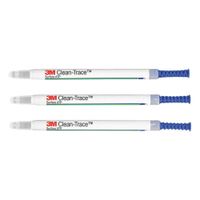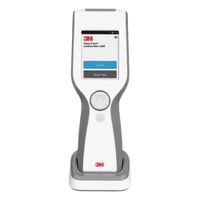Call +(254) 703 030 000 / 751 483 999 / 721 704 777
- Home
- Test Instruments
- Nonelectrical Properties Testing
- Cleaning Efficiency Meters Accessories
.....Read More
Frequently Asked Questions
What is ATP testing in cleaning efficiency meters?
ATP testing, or Adenosine Triphosphate testing, is a rapid testing method used to measure the cleanliness and hygiene of surfaces. It is commonly used in various industries, including healthcare, food and beverage, and hospitality, to ensure that cleaning processes are effective.
ATP is a molecule found in all living cells, and its presence on a surface indicates the presence of organic material, which could include bacteria, mold, or food residues. ATP testing involves using a luminometer and a swab containing a reagent. The swab is used to collect a sample from the surface being tested. When the swab is inserted into the luminometer, the reagent reacts with the ATP present, producing light. The luminometer measures the amount of light produced, which is directly proportional to the amount of ATP—and thus organic material—on the surface.
The results are typically expressed in Relative Light Units (RLU). A higher RLU reading indicates a higher level of contamination, suggesting that the cleaning process was not effective. Conversely, a low RLU reading indicates a cleaner surface.
ATP testing is valued for its speed and ease of use, providing immediate feedback on cleaning effectiveness. This allows for quick corrective actions if necessary. It is important to note, however, that ATP testing does not identify specific types of microorganisms; it only indicates the presence of organic material. Therefore, it is often used as part of a broader cleaning and hygiene monitoring program.
How do cleaning efficiency meters work?
Cleaning efficiency meters work by measuring the effectiveness of cleaning processes in removing contaminants from surfaces. These devices typically employ a combination of sensors and analytical techniques to assess cleanliness levels. Here's how they generally function:
1. **Detection Method**: Cleaning efficiency meters use various detection methods such as optical sensors, fluorescence, or ATP (adenosine triphosphate) bioluminescence. Optical sensors might measure the amount of light reflected from a surface, while fluorescence can detect specific substances that emit light when exposed to certain wavelengths. ATP bioluminescence measures the presence of organic material by detecting ATP, a molecule found in all living cells.
2. **Sampling**: The device collects samples from the surface being tested. This can be done through swabs, wipes, or direct contact with the sensor. The sample is then analyzed to determine the level of contamination.
3. **Analysis**: The collected data is processed to quantify the amount of residue or contaminants present. For example, in ATP testing, the sample is mixed with a reagent that reacts with ATP to produce light, which is then measured by the device. The intensity of the light correlates with the amount of organic material present.
4. **Results Interpretation**: The device provides a readout or digital display indicating the level of cleanliness. This can be a numerical value, a pass/fail indicator, or a more detailed analysis depending on the sophistication of the meter.
5. **Feedback and Adjustment**: The results can be used to assess the effectiveness of the cleaning process and make necessary adjustments. This feedback loop helps in optimizing cleaning protocols to ensure surfaces meet hygiene standards.
By providing real-time data on cleanliness, these meters help maintain high standards in environments where hygiene is critical, such as healthcare, food processing, and manufacturing.
What are the benefits of using cleaning efficiency meters?
Cleaning efficiency meters offer several benefits:
1. **Performance Monitoring**: They provide real-time data on the effectiveness of cleaning processes, allowing for immediate adjustments to improve outcomes.
2. **Cost Savings**: By optimizing cleaning processes, these meters help reduce the use of cleaning agents, water, and energy, leading to significant cost savings.
3. **Time Efficiency**: They enable quicker identification of areas that require more attention, streamlining cleaning operations and saving time.
4. **Quality Assurance**: Ensures that cleaning meets established standards, which is crucial in industries like healthcare and food processing where hygiene is critical.
5. **Data-Driven Decisions**: The data collected can be analyzed to make informed decisions about cleaning protocols and resource allocation.
6. **Environmental Impact**: By optimizing the use of cleaning materials and reducing waste, these meters contribute to more sustainable practices.
7. **Compliance and Reporting**: They assist in maintaining compliance with industry regulations and standards, and provide documentation for audits and inspections.
8. **Improved Safety**: Ensures that surfaces are properly cleaned, reducing the risk of contamination and the spread of pathogens, thereby enhancing safety for occupants.
9. **Enhanced Reputation**: Consistently high cleaning standards can improve customer satisfaction and enhance the reputation of a business.
10. **Employee Productivity**: By reducing the need for re-cleaning and ensuring efficient processes, employee productivity can be improved.
11. **Predictive Maintenance**: Helps in identifying trends and potential issues before they become significant problems, allowing for proactive maintenance.
12. **Customization**: Allows for the customization of cleaning protocols based on specific needs and conditions, ensuring optimal results.
How accurate are cleaning efficiency meters in detecting biological residue?
Cleaning efficiency meters, such as ATP (adenosine triphosphate) bioluminescence meters, are commonly used to assess the cleanliness of surfaces by detecting biological residues. These devices measure the presence of ATP, a molecule found in all living cells, to provide a rapid indication of contamination levels.
The accuracy of these meters in detecting biological residue can vary based on several factors:
1. **Sensitivity**: ATP meters are generally sensitive to a wide range of biological residues, including bacteria, food residues, and other organic materials. However, they may not differentiate between different types of residues or identify specific microorganisms.
2. **Surface Type**: The accuracy can be influenced by the type of surface being tested. Porous or textured surfaces may retain more residues, potentially leading to higher readings, while smooth surfaces may be easier to clean and test.
3. **Interference**: Non-biological substances that contain ATP or ATP-like molecules can interfere with readings, leading to false positives. Conversely, substances that inhibit the bioluminescence reaction can cause false negatives.
4. **Calibration and Maintenance**: Regular calibration and maintenance of the meters are crucial for accurate readings. Inconsistent calibration can lead to variability in results.
5. **Environmental Factors**: Temperature, humidity, and the presence of cleaning agents can affect the accuracy of ATP meters. Some cleaning agents may leave residues that interfere with ATP detection.
6. **Operator Technique**: Proper sampling technique is essential for accurate results. Inconsistent swabbing pressure or coverage can lead to variability in readings.
Overall, while ATP meters provide a rapid and convenient method for assessing cleanliness, they are not foolproof. They should be used as part of a comprehensive cleaning validation program, complemented by microbiological testing and visual inspections, to ensure thorough detection of biological residues.
What accessories are needed for cleaning efficiency meters?
To ensure the efficient cleaning of efficiency meters, several accessories are essential:
1. **Soft Brushes**: These are used to gently remove dust and debris from the meter's surface without causing scratches.
2. **Microfiber Cloths**: Ideal for wiping down surfaces, microfiber cloths trap dust and dirt effectively and are gentle on the meter's components.
3. **Compressed Air Canisters**: Useful for blowing out dust and particles from hard-to-reach areas, such as crevices and internal components.
4. **Cleaning Solutions**: Non-abrasive, anti-static cleaning solutions are recommended to remove grime and fingerprints without damaging the meter's surface.
5. **Cotton Swabs**: These are perfect for cleaning small, intricate parts of the meter, such as connectors and buttons.
6. **Protective Gloves**: Wearing gloves prevents oils and dirt from your hands from transferring to the meter, ensuring a clean finish.
7. **Lens Cleaning Kits**: If the meter includes optical components, specialized lens cleaning kits help maintain clarity and accuracy.
8. **Vacuum Cleaners with Attachments**: Small, handheld vacuums with brush attachments can effectively remove dust from larger areas.
9. **Antistatic Wrist Straps**: These prevent static electricity from damaging sensitive electronic components during cleaning.
10. **Tool Kits**: A basic set of screwdrivers and other tools may be necessary for disassembling parts of the meter for thorough cleaning.
11. **Protective Covers**: After cleaning, using protective covers can help keep the meter free from dust and dirt.
12. **Documentation**: Manufacturer's cleaning guidelines should be consulted to ensure compatibility with cleaning materials and methods.
These accessories collectively ensure that efficiency meters are cleaned effectively, maintaining their accuracy and prolonging their lifespan.
How do you maintain and calibrate cleaning efficiency meters?
To maintain and calibrate cleaning efficiency meters, follow these steps:
1. **Regular Inspection**: Conduct routine visual inspections to check for any physical damage or wear. Ensure all connections are secure and components are intact.
2. **Cleaning**: Regularly clean the meter using appropriate cleaning agents to remove any debris or residue that might affect its performance. Use non-abrasive materials to avoid damaging sensitive parts.
3. **Calibration Schedule**: Establish a regular calibration schedule based on the manufacturer's recommendations or industry standards. This ensures the meter provides accurate readings.
4. **Calibration Procedure**:
- **Reference Standards**: Use certified reference standards or solutions with known properties to calibrate the meter. These should be traceable to national or international standards.
- **Zero Calibration**: Start by calibrating the meter to a zero or baseline reading using a clean, uncontaminated sample.
- **Span Calibration**: Adjust the meter to read accurately across its full range using the reference standards.
- **Verification**: After calibration, verify the meter's accuracy by measuring known samples and comparing the results to expected values.
5. **Documentation**: Keep detailed records of all maintenance and calibration activities, including dates, procedures, and results. This documentation is crucial for quality control and compliance with regulatory requirements.
6. **Software Updates**: Regularly update the meter's software or firmware to ensure it operates with the latest features and improvements.
7. **Training**: Ensure that personnel responsible for maintenance and calibration are adequately trained and familiar with the equipment and procedures.
8. **Troubleshooting**: If the meter shows inconsistent or inaccurate readings, troubleshoot by checking for common issues such as sensor fouling, electrical faults, or software errors.
By following these steps, you can maintain the accuracy and reliability of cleaning efficiency meters, ensuring optimal performance in monitoring and controlling cleaning processes.
Can cleaning efficiency meters be used on all types of surfaces?
Cleaning efficiency meters, which measure the effectiveness of cleaning processes, can be used on various types of surfaces, but their applicability and accuracy can vary depending on the surface material and the specific technology of the meter. These devices often rely on methods such as ATP (adenosine triphosphate) testing, which detects organic material, or other technologies that measure surface cleanliness.
1. **Smooth, Non-Porous Surfaces**: These are ideal for cleaning efficiency meters. Surfaces like glass, metal, and certain plastics allow for accurate readings because they do not trap residues or microorganisms within their structure.
2. **Porous Surfaces**: Surfaces such as wood, fabric, or unsealed stone can pose challenges. The porosity can trap dirt and microorganisms below the surface, potentially leading to inaccurate readings. Some meters may not be sensitive enough to detect contaminants within the pores.
3. **Textured Surfaces**: Textured or uneven surfaces, like certain tiles or rough plastics, can also affect the accuracy of cleaning efficiency meters. The texture can create shadows or areas that are difficult for the meter to assess accurately.
4. **Specialized Surfaces**: Surfaces with coatings, such as anti-microbial or non-stick coatings, may interfere with the readings. The coatings can either mask the presence of contaminants or react with the testing method, leading to false results.
5. **Environmental Factors**: The environment, including lighting, temperature, and humidity, can also impact the performance of cleaning efficiency meters. These factors can affect both the surface being tested and the meter's sensors.
In conclusion, while cleaning efficiency meters can be used on a wide range of surfaces, their effectiveness and accuracy depend on the surface type and the specific technology of the meter. It is crucial to select the appropriate meter and method for the surface in question to ensure reliable results.

